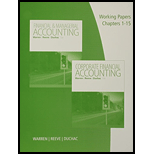
Concept explainers
a.
Disposal of Assets: Disposal is an activity of selling the worn-out assets that is no longer in need for the business, in return of some consideration. Disposal may be made in any of the following situations:
- Disposal with no gain no loss: When the asset is disposed with no consideration received.
- Disposal with gain: When the asset is disposed for more than its book value (original cost less
accumulated depreciation ). - Disposal with loss: When the asset is disposed for less than its book value.
Straight-line Depreciation: Under the straight-line method of depreciation, the same amount of depreciation is allocated every year over the estimated useful life of an asset. The formula to calculate the depreciation cost of the asset using the residual value is shown as below:
the annual amount of depreciation for the years 2013, 2014 and 2015 using the straight-line method of depreciation.
b.
the book value of the equipment on January 1of 2016.
c.
To record: the
d.
To record: the journal entry for the sale of the equipment on January 3 of 2016.
Want to see the full answer?
Check out a sample textbook solution
Chapter 9 Solutions
Working Papers, Volume 1, Chapters 1-15 for Warren/Reeve/Duchac's Corporate Financial Accounting, 13th + Financial & Managerial Accounting, 13th
- Afirm has an asset with a market value of $10,000 and a book value of $4,000. If its marginal tax rate is 25%, what will the net proceeds from selling the assetbe?arrow_forwardI am looking for the correct answer to this general accounting problem using valid accounting standards.arrow_forwardAccountingarrow_forward
- Question: Aho firm has actual sales of $69,000 in April and $57,000 in May. It expects sales of$74,000 in June and $97,000 in July and in August. Assuming that sales are the only source of cash inflows and that half of them are for cash and theremainder are collected evenly over the following 2 months, what are the firm's expected cash receipts for June, July, and August?arrow_forwardCan you help me solve this general accounting question using the correct accounting procedures?arrow_forwardHi expert please given correct answer with accounting questionarrow_forward
- Financial Accounting Question: A new common stock issue that paid a $1.77 dividend last year. The parvalue of the stock is $15, and the firm's dividends per share have grown at a rate of 7.8% per year. The growth rate is expected to continue in the foreseeable future. The price of this stock is now 27.33. The cost of common equity for the firm is __%.arrow_forwardCan you solve this general accounting question with the appropriate accounting analysis techniques?arrow_forwardI am searching for the accurate solution to this general accounting problem with the right approach.arrow_forward
- Financial Accounting Question: A new common stock issue that paid a $1.77 dividend last year. The parvalue of the stock is $15, and the firm's dividends per share have grown at a rate of 7.8% per year. The growth rate is expected to continue in the foreseeable future. The price of this stock is now 27.33. The cost of common equity for the firm is __%.Need Answerarrow_forwardPlease provide the accurate answer to this general accounting problem using valid techniques.arrow_forwardSolve with explanation and accounting questionarrow_forward
 Financial Accounting: The Impact on Decision Make...AccountingISBN:9781305654174Author:Gary A. Porter, Curtis L. NortonPublisher:Cengage Learning
Financial Accounting: The Impact on Decision Make...AccountingISBN:9781305654174Author:Gary A. Porter, Curtis L. NortonPublisher:Cengage Learning Intermediate Accounting: Reporting And AnalysisAccountingISBN:9781337788281Author:James M. Wahlen, Jefferson P. Jones, Donald PagachPublisher:Cengage Learning
Intermediate Accounting: Reporting And AnalysisAccountingISBN:9781337788281Author:James M. Wahlen, Jefferson P. Jones, Donald PagachPublisher:Cengage Learning Financial Reporting, Financial Statement Analysis...FinanceISBN:9781285190907Author:James M. Wahlen, Stephen P. Baginski, Mark BradshawPublisher:Cengage Learning
Financial Reporting, Financial Statement Analysis...FinanceISBN:9781285190907Author:James M. Wahlen, Stephen P. Baginski, Mark BradshawPublisher:Cengage Learning Cornerstones of Financial AccountingAccountingISBN:9781337690881Author:Jay Rich, Jeff JonesPublisher:Cengage Learning
Cornerstones of Financial AccountingAccountingISBN:9781337690881Author:Jay Rich, Jeff JonesPublisher:Cengage Learning





